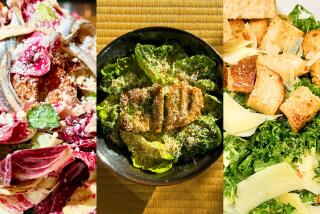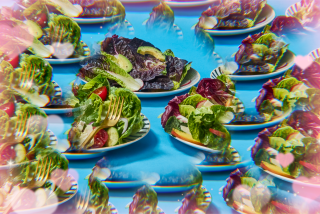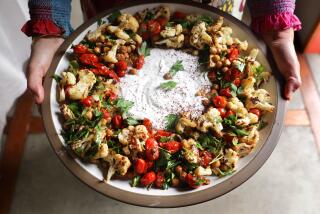Salad Bars: Fountains Of Fat?
- Share via
Hot weather and kitchen fatigue make salad bars an attractive option in summer. But hidden fat can lurk in even healthy-sounding offerings. Salad eaters trying to eat right may easily wind up with a meal as full of calories as a double cheeseburger with French fries and a milkshake. “It’s not hard to get 3,000 calories in a salad bar trip,” says California Dietetic Assn. spokesperson Susan Magrann, who factors in a muffin or two.
The problem often begins with piling your plate high. Taking one dip of each salad bar offering is a natural inclination. “People load up so well on the first trip,” says Paul Ellingsen, a Soup Exchange franchisee, “they don’t come back a lot (for a second helping).”
There’s no harm in plain fruits and vegetables, but among the blameless produce often sit prepared salads held together with fat--typically oil or mayonnaise. “The trend is definitely toward the prepared salad category,” says William Seckinger, vice president of marketing for Souplantation. “People used to lay a whole bed of greens and lay a whole bed of salad. But now they’ll have a trio of pasta salads.”
Even if you navigate around the prepared salads there are other problems. Salad dressings are an obvious source of fat and calories. The common ladles typically hold two ounces (four tablespoons), which can pack a bigger fat wallop than a salad eater might expect--up to 400 calories a scoop. And to those who have taken mountain-sized heaps of salad, one ladle of dressing doesn’t go very far and they often take several.
Another problem is garnishes and toppings. Sunflower seeds, cheese, crumbled bacon, crunchy Chinese noodles and olives all derive at least 50% of their calories from fat.
But don’t let all this keep you from digging into a salad. Salads are important nutritionally to Californians, who typically fall short in the produce department. According to a survey by the California Department of Health, two-thirds of Californians fail to get the minimum recommended health quota of five servings of fruits and vegetables per day.
“Our survey shows that salads are the number one way that Californians get their fruits and vegetables,” says Sue Foerster, chief nutritionist of the California Department of Health’s Cancer Prevention Program. “Salad bars are a convenient and fast way to get vegetables.”
According to several studies, populations that eat higher amounts of fruits and vegetables have lower rates of cancer. The protective agents are generally thought to be fiber and vitamins A and C. A promising new area of research is the compounds called phytochemicals, which have cancer-fighting properties. So far, phytochemicals have been found in vegetables readily available in salad bars such as broccoli, celery and carrots.
Of course, you don’t want to drown your cancer-fighting vegetables in fatty dressings. Fortunately you don’t have to. “There’s a whole range of options with vinegar splashes,” says Seckinger. “To have taste you don’t have to have oil.”
Another alternative is low-calorie salad dressings. According to the latest Gallup Poll sponsored by the National Restaurant Assn., reduced-calorie dressings have become much more available. Of restaurants where the average check is less than $8 per person, eight out of 10 were offering reduced-calorie salad dressings in 1990--up 21% in two years.
In a survey of 22,000 Soup Exchange customers, Ellingsen has also seen the demand for diet salad dressings increase. But to his surprise, the number one request was not diet dressing but more chocolate chip cookies. “Ironically, they are watching their calories,” says Ellingsen, “but nine out of 10 will take a cookie (when offered).”
More to Read
Eat your way across L.A.
Get our weekly Tasting Notes newsletter for reviews, news and more.
You may occasionally receive promotional content from the Los Angeles Times.








